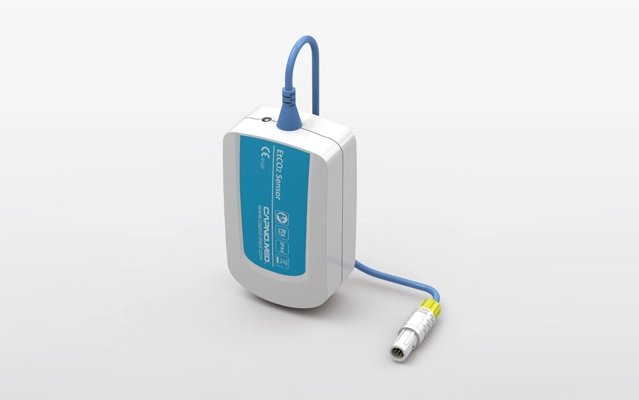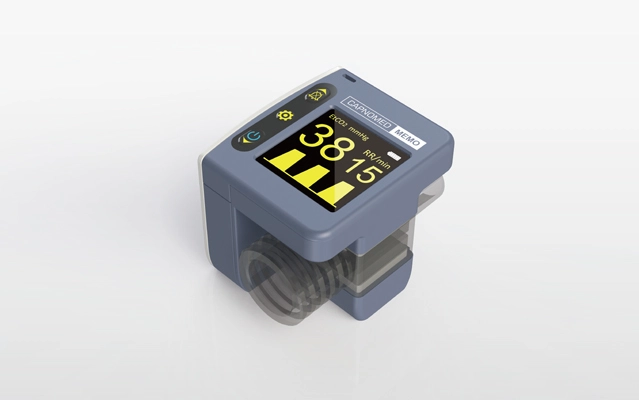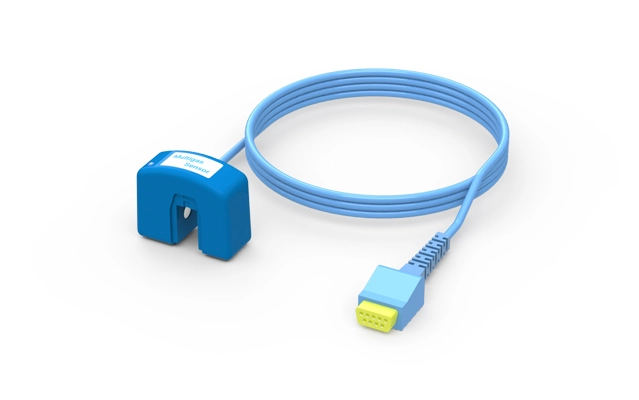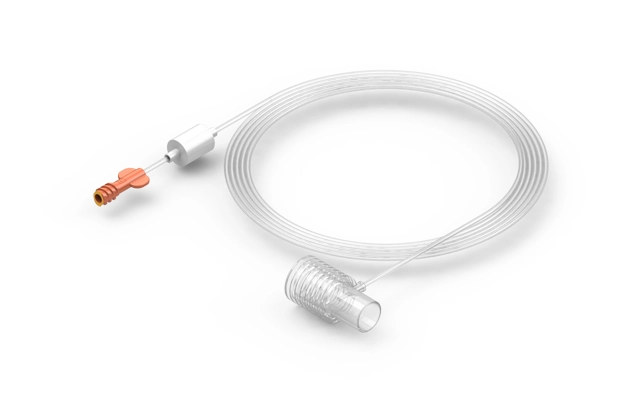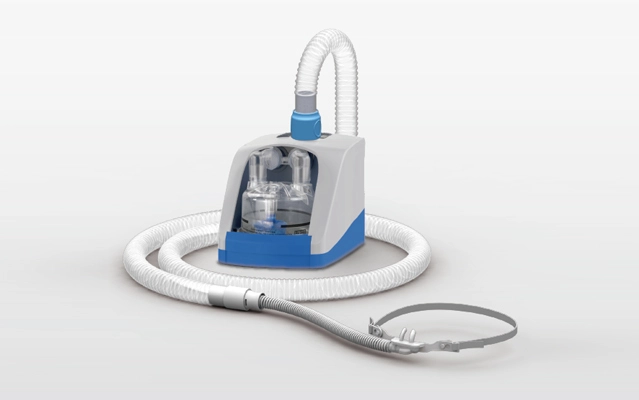In the realm of medical monitoring, capnography plays a pivotal role in assessing a patient's respiratory status. Two primary methods exist: mainstream and sidestream capnography. Understanding the nuances and differences between these techniques is crucial for healthcare professionals to make informed decisions regarding patient care.
What is Capnography?
Capnography is a non-invasive method used to monitor the concentration of carbon dioxide (CO2) in exhaled breath over time. It provides valuable insights into a patient's respiratory status and helps in diagnosing various conditions, including respiratory distress and airway compromise.
How Does Capnography Work?
Capnography operates through a series of precise and interdependent steps that start with capturing exhaled air and end with delivering actionable respiratory data.
The process involves the following steps:
1. Sampling of Exhaled Air:
A capnograph collects a sample of exhaled breath via a nasal cannula, face mask, or an airway adapter connected to an endotracheal tube. The device continuously captures air from the patient's respiratory cycle.
2. Infrared Spectroscopy:
Most capnographs utilize infrared (IR) spectroscopy to measure CO₂ levels. CO₂ molecules absorb specific wavelengths of infrared light. As the exhaled air passes through the sensor, the capnograph measures the intensity of absorbed IR light and calculates the CO₂ concentration.
3. Waveform Display:
The capnograph generates a capnogram, a graphical representation of CO₂ levels over time. This waveform has distinct phases:
Phase I: Baseline, representing CO₂-free air from the anatomical dead space.
Phase II: Upstroke, showing the transition as CO₂-rich air from the alveoli mixes with dead space air.
Phase III: Plateau, reflecting alveolar gas with steady CO₂ levels.
End-Tidal CO₂ (EtCO₂): The highest point in Phase III, indicating the peak CO₂ concentration at the end of expiration.
4.Interpretation:
Clinicians analyze the EtCO₂ value and waveform shape to evaluate ventilation efficiency, detect respiratory complications, and guide interventions. Changes in EtCO₂ levels or waveform patterns can indicate issues like hypoventilation, hyperventilation, airway obstruction, or compromised circulation.
In summary, the ability of capnography to capture detailed CO₂ data through infrared spectroscopy and present it in the form of capnograms makes it invaluable for monitoring ventilation, detecting complications, and guiding clinical decisions. With its precision and responsiveness, capnography plays a critical role in enhancing patient safety and improving outcomes in diverse medical settings.
Difference Between Mainstream and Sidestream Capnography
Mainstream Capnography: In-depth Analysis
Mainstream capnography involves the direct measurement of CO2 levels at the airway through a sensor placed directly in the breathing circuit. This method offers real-time monitoring and is commonly used in critical care settings such as operating rooms and intensive care units (ICUs).
Advantages of Mainstream Capnography
Immediate Detection: Since the sensor is placed directly in the breathing circuit, mainstream capnography provides immediate feedback on CO2 levels, enabling prompt intervention in case of respiratory compromise.
Accuracy: Direct measurement ensures high accuracy in CO2 monitoring, making it ideal for patients with compromised respiratory function.
Suitability for Intubated Patients: Mainstream capnography is particularly suitable for intubated patients undergoing mechanical ventilation, as it offers continuous monitoring without interference.
Limitations of Mainstream Capnography
Invasive Nature: Placement of the sensor in the breathing circuit can be invasive, potentially causing discomfort or airway irritation in some patients.
Equipment Compatibility: Mainstream capnography requires specialized equipment that may not be readily available in all healthcare settings.
Risk of Disconnection: There is a risk of sensor disconnection, which can lead to loss of monitoring data, especially during patient movement or transport.
Sidestream Capnography: Exploring the Alternative
Sidestream capnography, on the other hand, involves aspirating a small sample of exhaled air from the patient's airway through a sampling tube connected to the monitoring device. This sampled air is then analyzed for CO2 concentration.
Advantages of Sidestream Capnography
Non-invasive Sampling: Sidestream capnography offers non-invasive sampling, minimizing patient discomfort and reducing the risk of airway irritation.
Versatility: Sidestream capnography can be used in a variety of clinical settings, including emergency departments, ambulatory care, and procedural sedation.
Portability: The equipment for sidestream capnography is often more portable and compact, allowing for greater flexibility in monitoring patients outside traditional clinical environments.
Limitations of Sidestream Capnography
Sampling Delay: The sampling process introduces a delay in obtaining CO2 measurements, which may not be ideal for situations requiring immediate feedback.
Potential for Contamination: Sidestream sampling tubes can become contaminated with moisture or secretions, affecting the accuracy of CO2 measurements.
Interference with Ventilation: In patients with low tidal volumes or high respiratory rates, sidestream capnography may not provide accurate readings due to sampling inefficiencies.
| Feature | Mainstream Capnography | Sidestream Capnography |
| Sampling Method | Direct measurement from breathing circuit | Aspiration of a small sample of exhaled air |
| Response Time | Immediate | Delayed due to sampling |
| Accuracy | High accuracy due to direct measurement | Potential for reduced accuracy due to sampling and tube contamination |
| Invasive Nature | Invasive, requires sensor placement in breathing circuit | Non-invasive, minimal patient discomfort |
| Equipment | Specialized equipment, often less portable | More portable equipment, suitable for various settings |
| Suitability for Intubated Patients | Highly suitable | Can be used but may require adjustments for accurate readings |
| Risk of Disconnection | Higher risk of sensor disconnection | Lower risk of disconnection |
Choosing the Right Approach: Considerations for Healthcare Professionals
When deciding between mainstream and sidestream capnography, healthcare professionals must consider various factors, including the patient's clinical condition, the need for continuous monitoring, and the availability of equipment.
Clinical Indications
Mainstream: Ideal for intubated patients, those undergoing mechanical ventilation, and situations requiring continuous, real-time monitoring.
Sidestream: Suitable for non-intubated patients, ambulatory settings, and procedures where portability and non-invasive monitoring are prioritized.
Equipment Considerations
Mainstream: Requires specialized sensors and compatible monitoring equipment, which may limit its availability in certain healthcare settings.
Sidestream: Often more portable and versatile, with a wider range of compatible devices and accessories.
Patient Comfort and Safety
Mainstream: Can be invasive and may cause discomfort or airway irritation in some patients.
Sidestream: Offers non-invasive sampling, reducing the risk of patient discomfort and airway complications.
Mainstream and sidestream capnography are valuable tools in the assessment and monitoring of respiratory function. While mainstream capnography provides real-time monitoring and high accuracy, sidestream capnography offers versatility and non-invasive sampling. Healthcare professionals should carefully evaluate the clinical context and patient needs to choose the most appropriate monitoring approach.
 English
English
